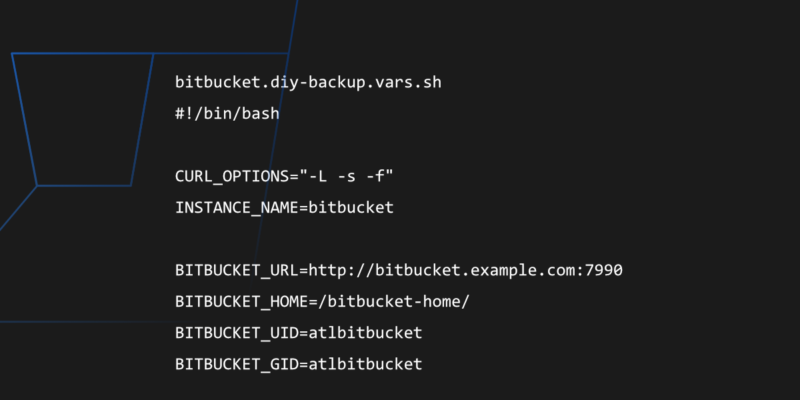
Bitbucket DIY Backup – Overview and Alternatives
The key to reducing downtime is to use the optimal, vendor-specific database and file system backup tools. Such tools are able to take snapshots (sometimes in a vendor-specific format) much faster than the generic, vendor-neutral format used by the Bitbucket Server Backup Client.
With DIY Backup, you can take advantage of your database’s incremental or fast snapshot tools, as well as your file server’s specific tools, for a more efficient backup. DIY Backup offers a way to control the backup process, allowing you to implement some custom modifications you need.
Read the following article to find out what the Bitbucket DIY Backup solution is and which data protection issues could it solved. how handy it is when it comes to securing your data. We’ll also show you various alternatives to this tool, so you can choose the most relevant one to meet your needs and requirements.
What is Bitbucket DIY Backup?
Bitbucket DIY Backup is a simple, effective way to back up your Bitbucket data. It’s a great option if you’re looking for a free and easy way to keep your data safe, but there are a few things to keep in mind before you get started.
First, Bitbucket DIY Backup is compatible only with Bitbucket Server versions 4.0 or up. If you’re using an older version of Bitbucket Server, you’ll need to upgrade it before you can start using Bitbucket DIY Backup.
Then, while Bitbucket DIY Backup is a great option for simple backups, it’s not suitable for large-scale or enterprise deployments. If you’re looking for a more robust solution, you may want to consider one of the paid options listed below.
Finally, keep in mind that Bitbucket DIY Backup is a self-contained solution. This means that you’ll need to take care of all the details yourself, including setting up regular backups and restoring your backups on your own if necessary.
What are the alternatives to Bitbucket DIY Backup?
If you’re looking for a more robust solution than Bitbucket DIY Backup, there are a few paid options available. One of such popular options is Atlassian’s own CloudBackup for Bitbucket Data Center.
CloudBackup is a comprehensive backup solution that includes features like incremental backups, automatic backup scheduling, and support for large-scale deployments.
Finally, let’s suppose you’re looking for a complete backup solution for your entire Atlassian stack – starting with Bitbucket, Jira, and Confluence. In this case, your desire to use GitProtect will definitely increase. Why? GitProtect is a SaaS solution that covers features provided by CloudBackup. But that’s just the beginning. There are a lot more advanced settings that you will find handy – like professional Disaster Recovery Technology, advanced task monitoring, audit logs, security reporting, password vault, and many more.
Eliminate data loss risk and ensure business continuity with the first TRUE Disaster Recovery software for Bitbucket.
Bitbucket DIY Backups using Bash scripts
Bitbucket is a popular online code hosting service that offers both free and paid plans. If you have a Bitbucket account, you will likely want to keep your data safe in case of an unexpected outage or data loss.
One way to back up your Bitbucket data is to use Bash scripts. Bash is a Unix shell and command language that can be used to automate various tasks. There are a few different ways to set up a Bash script for backing up your Bitbucket data.
One approach is to use the bitbucket-backup-to-s3 script, which is available on GitHub. This script will allow you to back up your Bitbucket data to Amazon S3.
Another approach is to use the bitbucket-backup script, which is also available on GitHub. This script will allow you to back up your Bitbucket data to a local directory. Once you have your Bash script set up, you can schedule it to run automatically using a cron job. A cron job is a time-based task that is typically used for automation purposes.
If you’re not comfortable setting up a Bash script to back up your Bitbucket data, there are some alternative solutions that you may want to consider. One option is to use a third-party backup service, like GitProtect. It will handle all your backups automatically after you set up your custom backup plan, which will take you less than 5 minutes.
Another option is to use the built-in export feature in Bitbucket. This feature will allow you to export your data from Bitbucket in a variety of formats, including JSON, XML, and ZIP. You can then store the exported data in a safe location, such as on an external hard drive or in the cloud. Regardless of the solution you choose, it’s important for you to regularly back up your Bitbucket data. By doing so, you’ll be able to restore your account in the event of an unexpected outage or data loss.
Restoring a DIY Backup
There are a number of reasons why you might want to restore a backup of your Bitbucket account – maybe you have accidentally deleted some critical data, or you just want to roll back to a previous version of your account. Whatever the reason is, restoring a backup is a relatively simple process.
To restore a backup, you’ll first need to download the backup file from wherever it is stored. Once you have the file, you can use the Bitbucket Restore tool to import the data. The Restore tool will walk you through the process of selecting the file and choosing which data to restore.
One thing to keep in mind is that restoring a backup will overwrite any existing data in your account. So, if you’re trying to restore a specific file or piece of data, make sure that you don’t have any other changes that you want to keep as they are before proceeding to this operation. If you’re not comfortable with the idea of restoring a backup yourself, there are a few alternatives that you can consider.
First, you can contact Bitbucket support and they can help you restore your account. Alternatively, there are third-party services that offer backup and restore services for Bitbucket. GitProtect is a DevOps backup platform that can greatly reduce your shared responsibilities and help you meet security requirements. Giving you full control over backups, allows you to fully utilize Disaster Recovery (a data protection standard of its own) or many more restore options. Forget about tedious manual backup and recovery management. Take full advantage of our 13+ years of market experience and just Backup. Recover. Stay compliant.






